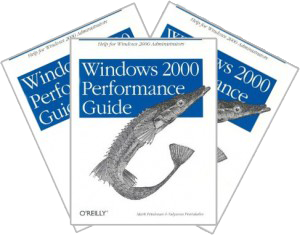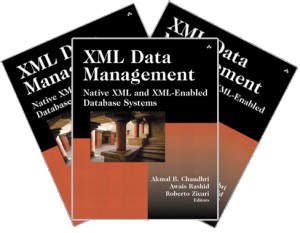Help for Administrators and Application Developers By Mark Friedman and Odysseas Pentakalos – January 2002 Buy from: Amazon
Windows 2000 Performance Guide

Description
It is characteristic of most computer systems that they do not degrade gradually. The painful reality is that performance is acceptable day after day, until quite suddenly it all falls apart. When this happens, the administrator needs to be prepared to help the organization get through the crisis.
Computer applications are growing ever more intelligent and easy to use. One of the by-products of making applications easier to use is that they usually also require more resources to run. And wherever productivity is a central factor in the decisions you make, performance considerations loom large and continue to play an important role in system management.
Are you wondering, for example, if more expensive equipment would give better performance? The answer is often yes, but not always. This book will show you why it is important to understand the performance characteristics of the hardware and of the workload, and how they match up against each other. Windows 2000 Performance Guide takes you through problem solving techniques like measurement methodology, workload characterization, benchmarking, decomposition techniques, and analytic queuing models.
This book covers:
The horror stories of failed development projects that did not meet cost and performance specifications reflect the fact that expectations about what computer technology can do far exceed the reality. Even as hardware performance continues to improve, managing performance will not get perceptibly easier. This book will give you the tools and information you need to meet the challenges of performance management now and in the future.
Many of the popular computer books out there promise easy answers, but this is the only book for those tricky situations that have no direct precedent. Windows 2000 Performance Guide will give you the information and the conceptual framework to become your own Windows 2000 performance expert.
Table of Contents
Click here for the full table of contents.
XML Data Management: Native XML and XML-Enabled Database Systems
Help for Administrators and Application Developers By Akmal B. Chaudhri, Awais Rashid, Roberto Zicari Buy from: Amazon

Description
In this book, you will find discussions on the newest native XML databases, along with information on working with XML-enabled relational database systems. In addition, XML Data Management thoroughly examines benchmarks and analysis techniques for performance of XML databases. This book is best used by students that are knowledgeable in database technology and are familiar with XML.
Table of Contents
Click here for the full table of contents.
This section contains articles about topics that relate to the work we do. Feel free to browse through the papers to see if any of the articles are of interest to you and please make sure you register with our mailing list so that you will be informed when new content is released.
Tuning J2EE Application Servers
In this paper we discuss tuning approaches for J2EE application servers. After covering tuning options at the architectural level of a J2EE application, we discuss the impact of garbage collection and the JVM on application server performance, talk about benchmarking, load-testing and monitoring of applications servers.
The paper is available here in PDF format.
Transfer Binary Data in an XML Document
XML has gained popularity as a platform- and language-independent format for transferring data across systems. In situations where you need to transfer binary data within an XML document, you must encode that binary data into an acceptable character format. This tip describes three different encoding approaches ranging from the simple to the most sophisticated techniques.
The paper is available here in PDF format.
Using EJBs and XML for Implementing an Image Management System
This paper describes and discusses the design and implementation of the JEDMICS OAI system, an EJB-based API that provides access to image data that is stored on a variety of storage media and metadata stored in a relational database system. The main focus of the paper is the use of XML as the portable data exchange solution, and its integration with the object oriented core of the system and the relational database that forms the persistent storage.
The paper is available here in PDF format.
Configuring the Windows 2000 I/O Subsystem
The Windows 2000 operating system brought considerable changes to the capabilities and configuration options of the I/O subsystem over those available with the Windows NT operating system. This paper will cover, in terms of impact on performance, the options available for configuring this very critical component of Windows 2000. We will describe the available choices at each layer of processing moving from the hardware level to the file system and application layer.
The paper is available here in PDF format.
Tuning the Performance of the Weblogic Application Server
The J2EE platform is a specification of a group of Java technologies and an application model for building enterprise applications using the Java language. The latest release of the Weblogic application server from BEA Systems has complete support for the J2EE platform and is currently the most popular server for building J2EE applications. In this paper we provide an introductory tutorial to the J2EE platform, the architecture of an application server, and then cover tuning options for the Weblogic server.
The paper is available here in PDF format.
This section lists some of the presentations that we have made recently for our customers or at industry conferences. Feel free to browse through the papers to see if any of the articles are of interest to you and please make sure you register with our mailing list so that you will be informed when new content is released.
Introduction to Cloud Computing
This is an introductory workshop on Cloud Computing The presentation introduced Cloud Computing conceptually and then reviewed the primary Cloud Computing offerings currently available by Amazon, Google, Microsoft and others.
The presentation is available for viewing on the web in PDF format.
Web Services, Service Oriented Architecture and the Enterprise Service Bus
This is an introductory workshop on how Web Services, Service Oriented Architectures and the Enterprise Service Bus can be used for Enterprise Application Integration.
The presentation is available for viewing on the web in PDF format.
Tuning the Performance of Java and J2EE Applications
This presentation provides a comprehensive overview on the development of high-performance Java-based applications and on the tuning of existing applications. Particular emphasis is placed on enterprise and server-side applications.
The presentation is available for viewing on the web in HTML format. or PDF format.
Web Services Development with the Apache Web Services Toolkit
This tutorial begins by describing Apache Axis, which forms the core of a web services solution. It then covers a number of projects under the Apache Web Services umbrella such as jUDDI, the open source implementation of UDDI; Sandesha, the implementation of the WS-ReliableMessaging protocol and a crucial component of a SOA implementation; and Kandula, the open source implementation of WS-Transactions.
The presentation is available for viewing on the web in HTML or PDF format.
Tuning the Performance of Java and J2EE Applications
This presentation provides a comprehensive overview on the development of high-performance Java-based applications and on the tuning of existing applications. Particular emphasis is placed on enterprise and server-side applications.
The presentation is available for viewing on the web in HTML format.
Using Web Services to Integrate J2EE and .NET Enterprise Applications
The Web services phenomenon promises to resolve all interoperability issues through an open architecture that is based on widely accepted industry standards such as SOAP, WSDL, and HTTP. This presentation explores component reuse across the two major enterprise application platforms, J2EE and .NET, using Web services as the medium of interaction. Through the use of examples, this tutorial covers the current state of interoperability between J2EE and .NET and focuses on best practices and issues that arise.
The presentation is available for viewing on the web in HTML format.
Tuning J2EE Application Servers Presentation
In this presentation we discuss tuning approaches for J2EE application servers. After covering tuning options at the architectural level of a J2EE application, we discuss the impact of garbage collection and the JVM on application server performance, talk about benchmarking, load-testing and monitoring of applications servers.
The presentation is available for viewing on the web in HTML format.
Configuring the Windows 2000 I/O Subsystem
The Windows 2000 operating system brought considerable changes to the capabilities and configuration options of the I/O subsystem over those available with the Windows NT operating system. This presentation covers, in terms of impact on performance, the options available for configuring this very critical component of Windows 2000.
The presentation is available for viewing on the web in HTML format.
